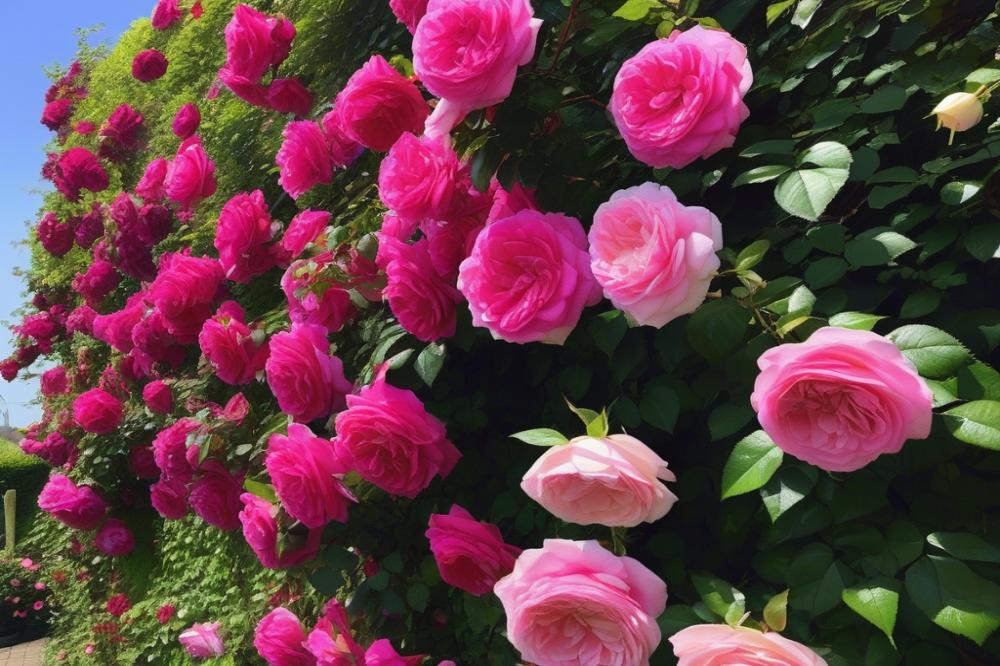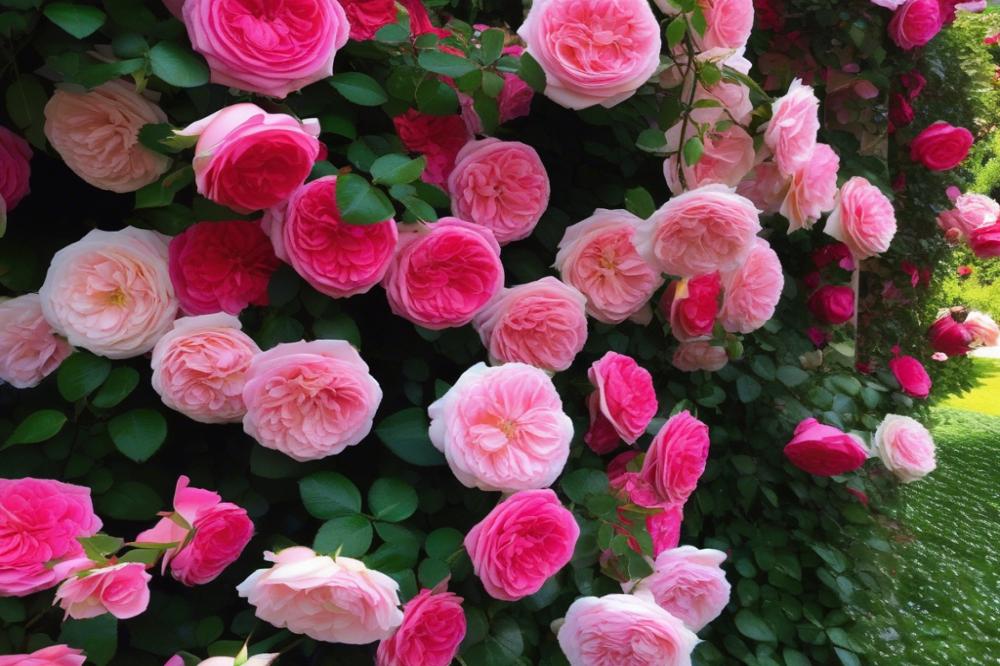How to Train climbing roses for a Stunning Vertical Display
Overview of climbing roses and Their Appeal in vertical gardening
Climbing roses enchant many garden enthusiasts with their vibrant blooms and lush foliage. These plants can transform bland walls and fences into a stunning vertical landscape. Traditionally, roses are viewed as bushy plants, but when trained properly, they offer a new dimension to gardening. Using a rose trellis not only supports the plants but creates an elegant visual that captivates the eye. Imagine walking through a garden bursting with color and fragrance, where flowering plants intertwine in beautiful harmony.
The essence of training climbing roses lies in their ability to flourish in confined spaces. vertical gardening provides an opportunity to maximize your garden’s potential without sacrificing valuable ground space. By guiding these plants upward, you can create a breathtaking display that changes with the seasons. Proper care and attention will embrace their natural beauty, allowing them to fill your outdoor setting with splendor.
Importance of training climbing roses for Stunning Displays
Training climbing roses is vital for achieving that picturesque look. When you properly manage their growth, you lead them into a structured form that enhances their aesthetic appeal. Pruning roses is an essential practice that promotes healthier plants. Regular maintenance helps control their size and directs new growth towards supports. This careful attention not only nurtures the plant but also significantly influences its blooming patterns.
Moreover, the right plant support makes all the difference. A sturdy trellis or arbor allows roses to climb effectively. This enhances airflow and light exposure, creating optimal conditions for growth. A well-trained plant not only looks beautiful but thrives and produces more flowers. Your commitment to this process will result in a lush display that can be the focal point of any garden design.
Connection to Outdoor Aesthetics and Garden Design
Climbing roses serve as a perfect blend of form and function in outdoor aesthetics. They can soften hard structures like fences, adding color and life to otherwise dull spaces. By integrating these plants into your landscape, you will elevate the overall design of your garden. Strategically placing them near entrances or along pathways creates inviting spaces that encourage exploration.
Different climbing rose varieties offer unique colors and fragrances that cater to various tastes. Whether you prefer classic reds or delicate pastels, these roses can complement any style. Using them effectively can also bring harmony to diverse elements within your garden. Therefore, mastering the art of training climbing roses becomes crucial for anyone eager to achieve stunning vertical displays. With commitment and the right techniques, your outdoor haven will flourish like never before.
Understanding Climbing Roses

Climbing roses are not your average flowering plants. They are designed to ascend. This climbing feature allows them to create stunning vertical displays, often found on rose trellises or along walls. Striking blooms cover an upward-facing lattice, adding charm to any outdoor aesthetics.
Many climbing rose varieties exist, each with distinct traits. For instance, New Dawn is beloved for its soft pink blooms and moderate fragrance. Similarly, Don Juan boasts rich red petals and a powerful aroma. These vigorous growers can flourish in several conditions, making them ideal for vertical gardening projects. Selecting the right variety can significantly impact your garden design.
Differentiating climbing roses from other types is crucial for successful gardening. While hybrid tea roses focus on a single stem with blooms at the top, climbing types grow multiple canes. This allows them to thrive on plant support structures. Understanding the pruning roses technique is also important. Proper pruning encourages new growth and ensures better air circulation, reducing disease risk.
When approaching vertical landscape design, consider the growth habits of your selected roses. Unlike bush roses, which stay compact, these unique varieties excel in height, creating a vertical focus in your garden. You’ll find that their resilience and adaptability make them an excellent choice for various outdoor environments.
Choosing the Right Plant Support

When you think about training climbing roses, remember that a sturdy rose trellis is key to their success. This support acts as a backbone for these beautiful plants, allowing them to flourish and create stunning vertical displays. Without proper structure, these flowering plants can become tangled or weak, hindering their growth and blooms.
Different Types of Support Structures
Trellises are a popular choice for supporting climbing roses. They allow plants to climb upward while being visible from all angles. Arbors play a similar role but provide a stunning archway for your garden. Consider incorporating one into your outdoor aesthetics for an impressive look. Fences, too, can serve as effective plant support. The right type of support can become a focal point in your garden design.
Selection and Positioning of Plant Supports
Choose the support structure based on the specific climbing rose varieties you select. Some plants need a sturdy frame, while others may thrive on lighter supports. Positioning is vital; place your support in a spot that receives plenty of sunlight. This positioning promotes healthy growth. Be mindful of soil quality, too, as this can affect how well your roses establish roots. Once you’ve chosen the right support, make sure to secure it well. Sturdiness will help your roses through wind and rain.
After installing your support, incorporate careful rose care. Regularly check the connections and make adjustments as needed. While training, pruning roses will also play a critical part in guiding their growth. Wrap the stems gently around the support, allowing them to cling as they grow. Over time, your roses will cover the support beautifully, transforming your vertical landscape.
The Training Process

Step-by-step guide to training climbing roses
Training climbing roses starts with selecting the right plant support. A sturdy rose trellis is an excellent choice. Begin the training right after planting. Focus on the first few shoots that grow. These will be your leading stems. Position them towards the support structure at a gentle angle. This helps the plant grow upward, creating a beautiful display.
Regularly check for new growth. Pinch off any wayward shoots that do not fit your design. Pruning roses at this stage is crucial. Trim the stems to shape the plant and encourage side shoots. This encourages fullness and blossoming in future seasons.
Techniques for guiding stems along the support
Once your main stems are directed towards the trellis, use soft ties to secure them. Look for materials that won’t damage the stems. Craft twine or strips of cloth work nicely. Gently loop the ties around the stems, attaching them to the support. Too tight a grip can harm the plant. Allow some movement for growth.
Consider weaving the stems through the trellis slats. This technique promotes stability and creates a unique pattern. If the trellis is tall, remember to guide the growth periodically. Approach each stem like a partner in a dance—direct them carefully, ensuring they line up beautifully with the structure.
Tips for securing and spacing branches for maximum coverage
Spacing branches is essential for a thriving vertical landscape. Aim for enough room between branches to allow air circulation. This practice prevents disease, enhancing rose care. Each branch should have its own space to shine.
Use clips or small plant supports to help guide wandering branches. This can harmonize the overall design of your garden. Remember to gradually train any new growth as the season progresses. This continuous attention transforms your climbing roses into flowering plants that contribute to outdoor aesthetics.
While working, observe different climbing rose varieties. Each type may grow differently. Adjust your techniques according to their unique habits for the best results. Create a stunning spectacle that will draw the eye and delight your garden visitors.
Pruning Roses for Healthy Growth

Best Times to Prune Climbing Roses
Most gardeners agree on the best time to prune. Late winter or early spring is ideal, just before new growth begins. At this stage, the plant is still dormant. Regular checks for frost will help you time it right. Pruning too early can expose tender new growth to frost damage. Waiting too long can lead to reduced blooms for the season.
Effective Pruning Techniques to Promote Flowering and Prevent Overgrowth
Start by removing any dead or damaged stems. This helps to redirect energy toward healthy growth. Next, focus on the shape of the plant. Cut back long canes to a few strong buds. This encourages robust flowering as well. Consider thinning crowded areas to improve air circulation. Healthy airflow reduces the risk of disease.
When you look at the climbing rose varieties, each has specific needs. Some may require more severe pruning, while others thrive with a lighter touch. Always keep the overall design of your garden in mind. Imagine how the structure of the rose will fit on the trellis. Your garden design should be harmonious, allowing each plant to shine.
Importance of Deadheading and Maintaining Shape
Deadheading is essential for prolonging blooms. Removing spent flowers helps the plant channel energy into producing new buds. It also keeps the overall appearance neat and attractive. Maintain a consistent shape by training new growth along the plant support system. This not only enhances outdoor aesthetics but makes care easier.
Consistent attention to pruning roses ensures a more vibrant display. With proper care, vertical gardening becomes a rewarding experience. The key is to establish a routine that nurtures both health and beauty. Plants flourish when they have room to grow without interference. Enjoy watching your vertical landscape fill with life.
Rose Care Essentials
Climbing roses thrive in specific conditions that make their beauty shine. Watering these plants properly is crucial. Aim for consistent moisture, especially during the growing season. When watering, soak the soil but avoid getting the leaves wet. This practice helps prevent diseases and keeps your plants healthy.
Soil quality cannot be overlooked. Using well-draining, nutrient-rich earth is a must. Add organic matter like compost for an extra boost of nutrients. A pH level between 6.0 and 6.8 works best. Regular testing can help maintain these ideal conditions.
Pest and Disease Management
Taking care of climbing roses includes being vigilant about pests and diseases. Aphids, spider mites, and Japanese beetles can become troublesome. Regularly inspect leaves for any signs of these invaders. If you notice a problem, act quickly. Neem oil is an effective, natural way to fight infestations.
Fungal diseases like black spot and powdery mildew can also be an issue. Provide ample air circulation by spacing plants properly. Pruning roses not only shapes their appearance but also improves airflow, minimizing disease chances. Always remove any infected leaves to reduce the spread.
Seasonal Care Tips
Throughout the seasons, some attention to detail pays off. Fertilizing climbing roses three times a year enhances growth and flowering. Spring is ideal for the first application, followed by a second in mid-summer. Use a balanced, slow-release fertilizer for lasting effects.
Consider mulching around your plants to retain moisture and suppress weeds. This simple step can dramatically affect how they grow. In fall, when blooms fade, ensure to prune to prepare for the next year. Cutting back helps promote healthy new growth in spring.
In your garden design, a rose trellis creates a beautiful display. Climbing rose varieties can add color and texture to your outdoor aesthetics. These flowering plants truly transform vertical landscapes. With proper rose care, you can create a stunning vertical display that is both charming and inviting.
Creating a Stunning Vertical Landscape
Incorporating climbing roses into your overall garden design opens doors to vibrant beauty. These plants grow upwards, creating stunning, eye-catching displays on structures like a rose trellis. You can transform dull walls or fences into splendid vertical landscapes. Vertical gardening allows you to maximize your space while adding depth to your outdoor aesthetics.
Pairing Climbing Roses with Other Flowering Plants
Mixing climbing rose varieties with other flowering plants can create a lively, colorful garden. Consider adding lilacs or daisies for bursts of different colors. This combination not only diversifies your garden but also enhances the visual interest. Placing complimentary plants nearby allows each flower to shine. Grouping colors creates harmony. Think about how much brighter your space can become with this simple addition!
Enhancing Vertical Displays with Color and Texture
Carefully choosing and arranging plants can make your displays more appealing. Adding elements with varying textures can draw attention. Tall sunflowers or delicate astilbes can complement roses beautifully. Think outside the box here. Even non-flowering plants, like ornamental grasses, can provide that needed contrast. Pruning roses properly will encourage flourishing blooms. Remember to consider their blooming seasons, too, for continuous color. Plant support is crucial for maintaining a tidy appearance.
Experimenting with color schemes can set a mood for your outdoor space. Whether you prefer soft pastels or bold hues, there’s a combination that can inspire you. Take your time in planning your design. A well-planned arrangement will give you the utmost satisfaction as your climbing roses thrive. Each season can showcase different features of your vertical landscape. With rose care and attention, your garden will surely be the envy of the neighborhood.
Final Thoughts on Training Climbing Roses
Training climbing roses is not just a gardening chore; it’s an essential practice that transforms any outdoor space. With the proper techniques, you can guide these beautiful plants to grow upward, creating a stunning vertical display. Such displays can turn an ordinary backyard into a breathtaking retreat full of color and life.
Vertical gardening is an exciting avenue to explore. It allows you to maximize your space while showcasing your creativity. More than just aesthetics, it brings a sense of tranquility. Picture a rose trellis adorned with delicate blooms swaying gently in the breeze. This image can enhance not only the beauty of your garden but also your mood as you spend time outside.
The satisfaction derived from cultivating vivid, vertical displays is truly rewarding. Watching your efforts blossom into something spectacular is a joy like no other. Every step—staking, tying, and pruning—pays off when you see the vibrant roses climbing effortlessly. Embrace the challenge, and don’t shy away from experimenting with your climbing plants.
In conclusion, training climbing roses offers both beauty and a fulfilling gardening experience. Dive into vertical gardening and heighten your enjoyment in creating stunning spaces. Your garden can become an inspiring expression of nature’s art, all thanks to your dedication and creativity.



